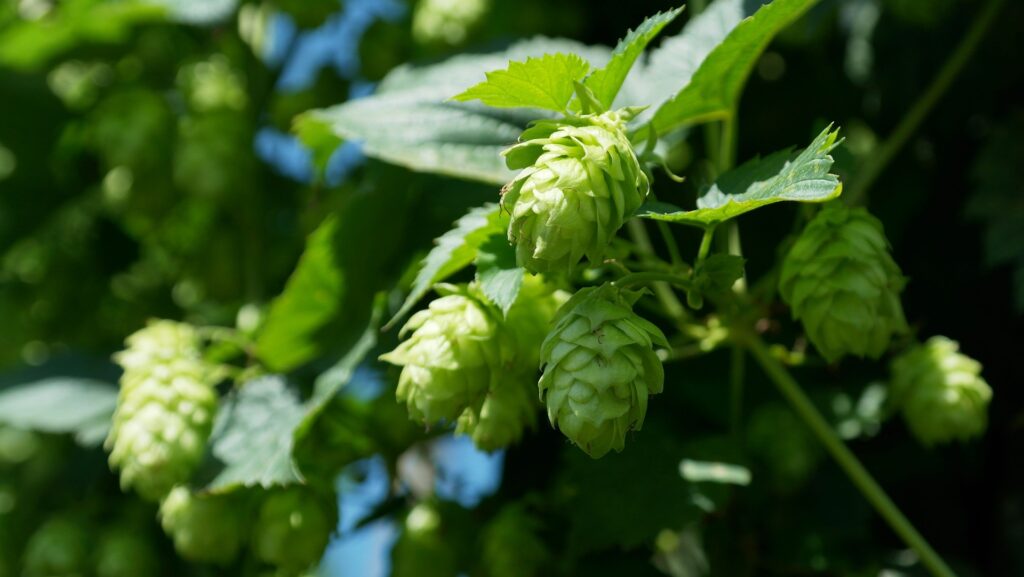If you drink beer, the distinct aroma and taste of hops is unmistakable. This bitter, oily flower has been used as an additive in beer since at least the 9th Century. In this ‘Ingredient Spotlight’ we look at the humble hop plant or humulus lupulus. We’ll take a look at what hops are, how they aid in beer production and just a little bit of the science of this wonderful plant.
What are hops?
Hops are a flowering plant that are part of the cannabaceae family. If that Latin name sounds vaguely familiar, it’s because the humble humulus is closely related to another aromatic plant that humans seem to love: cannabis. Both plants are sticky, aromatic and dioecious (meaning that there are male and female varieties of the plant). Typically, only the female hop plants are commercially grown as the seeds resulting from pollination with male plants are undesirable for beer production.
Hops are perennial plants, which simply means they live for two or more years or growing seasons. They are largely dormant over the winter before exploding into vigorous growth and flowering in the summer. They resemble a vine, but technically are known as “bine”: they use stiff hairs to aid in “climbing” rather than tendrils, which are characteristic of a vine (like grapes).
Hops have been used in beer for centuries as they impart a unique flavour, are antimicrobial and improve time that the beer can be stored for. Much like yeast in beer, hops were used by brewers long before anyone understood the science behind the ingredient.
History of hops in beer
The hop plant (probably) originated in China and made its way to the European brewhouses in approximately the 9th century when brewers outside of Munich started using hops in place of a range of other additives. Before the widespread use of hops, other plants such as heather, yarrow, and gruit were used to flavour beer. However, hops eventually became the preferred flavouring agent due to their unique qualities that suited beer production and storage.
By the 16th century hops had largely taken over these other additives to become the key flavouring and preserving agent of beer. It is around this time we see the emergence of what we call the Noble Hops: the traditional varieties that formed the foundation for traditional beer production: Hallertauer Mittelfrüh, Tettnang, Spalt and Saaz. As agriculture, science and beer production modernised, we saw the emergence of many new types of hops in Europe, the UK and beyond.
These days we tend to differentiate Noble hop and New World hops. New World hops are more modern varieties that tend to have more complex and bitter characteristics. These new hops can have a spectrum of flavours from fruity to outrageously bitter and are often more resistant to pests and diseases (such as Downy Mildew which devastated hop production on the east coast of the USA in the early 20th century).
Why use hops in beer?
You may have heard of the famous tale of thirsty British soldiers who were stationed in the British colonial outpost of India in the 18th century. At the time, there was no local beer production in India so barrels of beer had to be shipped from the brewhouses in England. To keep the beer fresh during the long journey, a generous amount of hops was added to the beer, thus creating the India Pale Ale (IPA) style.
While the Brits didn’t really understand the science behind the hops in their IPA, they understood that there was something special in the plant that made it extremely useful for brewing. It’s the unique chemical composition of hops that make them desirable to brewers: alpha acids, beta acids, oils and flavonoids make for the perfect brewing companion.
Hops are used primarily in the brewing of beer to impart flavour, bitterness, and aroma. Alpha acids are responsible for the bitterness in beer, while beta acids are less bitter and have antimicrobial properties that help preserve the beer. The essential oils in hops contribute to the aroma of the beer, which can range from floral and fruity to spicy and earthy. Hops not only add bitterness to beer, but also help to preserve it by inhibiting the growth of bacteria and other microorganisms. This was especially important during the mediaeval period when beer was often contaminated with harmful bacteria.
How to use hops in beer
Typically brewers will use pellets, dried or fresh flowers or liquid concentrates when adding hops to their brew. When brewing, adding hops at different stages will produce different effects. Bittering hops are added at the start of the boil: the boiling process creates isomerization of some of the acids within the flower, transforming them into iso-a-acids. Basically, this means the flavours and aromas are burnt off while the hops impart a bitter taste to the beer.
For some beer styles, hops will also be added toward the end of the boil. This is typically done to impart the aroma of the hops into the wort (without isomerization adding too much bitterness). Different recipes will call for different “schedules” of hop additions that will result in unique flavour profiles.
Hops can also be added to a brew during or after fermentation – this is known as dry hopping. Dry hopping usually takes place after fermentation has finished (typically a few days before bottling) and can easily be achieved in home brewing by (carefully) adding some hops into your fermenter. Dry hopping is useful for imparting aroma and flavour as without being boiled, they will not impart much bitterness.
There is also a growing trend in some “craft” breweries of adding hops to the mash (i.e. before the boil) although the effectiveness of this method is hotly debated and not something that I’ve tried personally.
Today, hops are an essential ingredient in modern beer-making, with many different varieties available, each with its unique flavour and aroma characteristics. The use of hops in beer has come a long way since their first documented use, and they continue to play a crucial role in the brewing process.
Read next: Top 6 Craft Beer Industry Trends To Watch Out For In 2023






